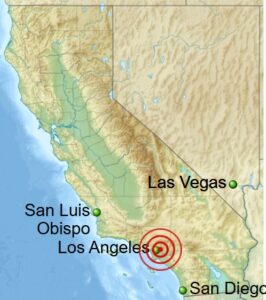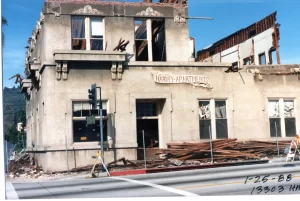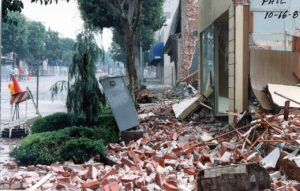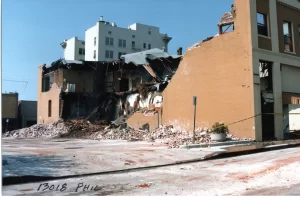
 The quiet morning of October 1, 1987, was suddenly shattered at 7:42 am by the ominous shaking of a 6.1 earthquake. The quake, located in Whittier, California, killed 6 people and injured 100 more that fateful day. The quake, named the 1987 Whittier Narrows Earthquake, lasted 30 seconds, violently waking residents from sleep, with items tumbling to the floor. The quake ruptured gas lines, sparking several fires. As is usually the case, falling debris was the cause of the loss of lives and the injuries. In addition, there were significant highway disruptions. Remarkably, no substantial building collapses occurred despite the intense shaking. It was the largest quake to hit Southern California since 1971. Nevertheless, it was not nearly as damaging as the Northridge quake that would devastate parts of Los Angeles seven years later.
The quiet morning of October 1, 1987, was suddenly shattered at 7:42 am by the ominous shaking of a 6.1 earthquake. The quake, located in Whittier, California, killed 6 people and injured 100 more that fateful day. The quake, named the 1987 Whittier Narrows Earthquake, lasted 30 seconds, violently waking residents from sleep, with items tumbling to the floor. The quake ruptured gas lines, sparking several fires. As is usually the case, falling debris was the cause of the loss of lives and the injuries. In addition, there were significant highway disruptions. Remarkably, no substantial building collapses occurred despite the intense shaking. It was the largest quake to hit Southern California since 1971. Nevertheless, it was not nearly as damaging as the Northridge quake that would devastate parts of Los Angeles seven years later.
Southern California was shaken by a prolonged series of aftershocks in the days following the earthquake. Many people were hesitant to return to their homes, so they chose to camp in public parks for an extended period of time, until things settled down again. As a safety measure, hospitals were preemptively evacuated. While there were isolated incidents of looting amidst the turmoil, they were not widespread.
The earthquake occurred on a blind thrust fault. A blind thrust earthquake happens along a thrust fault that leaves no signs on the Earth’s surface, which is why it’s termed “blind.” These faults, hidden from view, elude standard geological mapping on the surface. Occasionally, they are detected incidentally during oil exploration with seismic methods; otherwise, their presence may remain unsuspected…until the quake occurs.
Whittier, a small town located south of Los Angeles, is primarily known as the birthplace of President Richard Nixon. However, Nixon’s birth was not the only time Whittier was in the news. In fact, this quake was not the first earthquake to strike Whittier. The 1929 Whittier earthquake struck on July 8, registering a local magnitude of 4.7 and a maximum intensity of VII (Very Strong) on the Mercalli intensity scale. The tremor, with a depth of 8.1 miles, was felt most acutely southwest of the city, where it caused significant damage to a school and two houses and led to the collapse of chimneys in other homes. In Santa Fe Springs, oil derricks were affected, and minor ground fissures were observed. That earthquake’s impact was noted from Mount Wilson to Santa Ana, and from Hermosa Beach to Riverside, with numerous aftershocks continuing until early 1931.
The 7:42 am quake was the most intense in the Los Angeles region since the 1971 San Fernando quake, reaching as far as San Diego, San Luis Obispo, and Las Vegas. Communications and local media were disrupted, power outages occurred, and many early workers were trapped in inoperative elevators. Additional 
 devastations included several water and gas main ruptures, broken windows, and partial ceiling collapses. Similar to the San Fernando quake, transportation was impacted, with the Santa Ana and San Gabriel River Freeways closed near Santa Fe Springs due to dislodged concrete and visible cracks. Damage from the 1987 Whittier earthquake is estimated at $100 million.
devastations included several water and gas main ruptures, broken windows, and partial ceiling collapses. Similar to the San Fernando quake, transportation was impacted, with the Santa Ana and San Gabriel River Freeways closed near Santa Fe Springs due to dislodged concrete and visible cracks. Damage from the 1987 Whittier earthquake is estimated at $100 million.


One Response to Whittier Narrows Quake